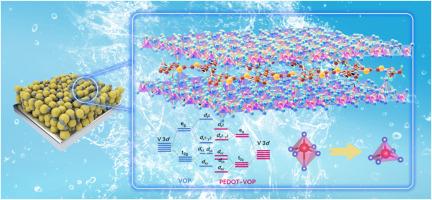Efficient modulation of vanadium spin state via poly(3,4-ethylenedioxythiophene) functionalization for enhanced zinc ion storage
IF 14.2
1区 材料科学
Q1 ENGINEERING, MULTIDISCIPLINARY
引用次数: 0
Abstract
Layered VOPO4·2H2O (VOP) cathodes exhibit promising advantages for aqueous zinc-ion capacitors (ZICs) but hindered by inferior structural stability and poor bulk conductivity. Herein, a PEDOT-VOPO4·2H2O (PEDOT-VOP) cathode has been developed, achieving an enlarged interlayer spacing of 9.7 Å (compared to 7.4 Å for single VOP) through effective polymer intercalation. The π-conjugated chain of PEDOT forms a delocalized hybrid state with the orbitals of vanadium, introducing asymmetrical spin polarization and thereby enhancing the intrinsic electronic conductivity of VOP. Furthermore, the PEDOT insertion modifies the local crystal field symmetry of VOP, resulting in the reorganization of orbital splitting energy levels. This significantly modifies the bond strength between V and O by altering the original [VO6] octahedral structure into a distorted VO5 pyramidal structure, which in turn enhances structural stability. Consequently, the PEDOT-VOP cathode demonstrates a specific capacity of 512.7 mAh g−1 at a wide potential window of 1.5 V in aqueous electrolyte under a current density of 1 A g−1. In-situ Raman and XRD analysis confirm the excellent reversibility and long-term stability of the cathode, with 88 % of its initial capacity retained over 10,000 cycles. This study provides profound insights into the development of high-voltage, stable, and high-capacity cathode materials for ZICs by modulating the electronic structure through enhanced spin polarization of d-orbitals.

通过聚(3,4-乙烯二氧噻吩)功能化有效调节钒自旋态以增强锌离子储存
层状voo4·2H2O (VOP)阴极在水性锌离子电容器(ZICs)中表现出良好的优势,但由于结构稳定性差和体电导率差而受到阻碍。本文开发了一种pedot - voo4·2H2O (PEDOT-VOP)阴极,通过有效的聚合物插层,实现了9.7 Å的层间距扩大(相比之下,单个VOP为7.4 Å)。PEDOT π共轭链与钒的轨道形成离域杂化态,引入不对称自旋极化,从而提高了VOP的本征电子导电性。此外,PEDOT的插入改变了VOP的局部晶体场对称性,导致轨道分裂能级的重组。这将原来的[VO6]八面体结构改变为扭曲的VO5锥体结构,从而显著改变了V和O之间的键合强度,从而提高了结构的稳定性。因此,在1 a g−1电流密度下,PEDOT-VOP阴极在1.5 V宽电位窗口下的比容量为512.7 mAh g−1。原位拉曼和XRD分析证实了阴极优异的可逆性和长期稳定性,在10,000次循环后其初始容量保留了88%。本研究通过增强d轨道的自旋极化来调制电子结构,为开发高电压、稳定、高容量的ZICs正极材料提供了深刻的见解。
本文章由计算机程序翻译,如有差异,请以英文原文为准。
求助全文
约1分钟内获得全文
求助全文
来源期刊

Composites Part B: Engineering
工程技术-材料科学:复合
CiteScore
24.40
自引率
11.50%
发文量
784
审稿时长
21 days
期刊介绍:
Composites Part B: Engineering is a journal that publishes impactful research of high quality on composite materials. This research is supported by fundamental mechanics and materials science and engineering approaches. The targeted research can cover a wide range of length scales, ranging from nano to micro and meso, and even to the full product and structure level. The journal specifically focuses on engineering applications that involve high performance composites. These applications can range from low volume and high cost to high volume and low cost composite development.
The main goal of the journal is to provide a platform for the prompt publication of original and high quality research. The emphasis is on design, development, modeling, validation, and manufacturing of engineering details and concepts. The journal welcomes both basic research papers and proposals for review articles. Authors are encouraged to address challenges across various application areas. These areas include, but are not limited to, aerospace, automotive, and other surface transportation. The journal also covers energy-related applications, with a focus on renewable energy. Other application areas include infrastructure, off-shore and maritime projects, health care technology, and recreational products.
 求助内容:
求助内容: 应助结果提醒方式:
应助结果提醒方式:


